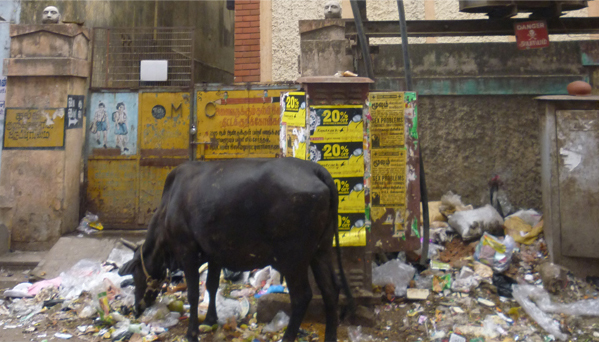
A Chennai street corner, the picture speaking louder than words.
Our city of Madras that is Chennai has had many firsts to its credit. But this is one that it may not be proud of. If the report by the Waste-To Energy Research and Technology Council (WTERT) is to be believed Chennai generates 0.71kg of waste per capita, with Kolkata and Delhi at 0.66 and 0.65kg respectively coming a distant second and third. It does not make for edifying reading.
The details are even more frightening. Around 6,404 tonnes of garbage is generated every day by the city, with every household contributing 30 per cent recyclable, 60 per cent organic and 10 per cent hazardous waste. This is in addition to 9,898kg of bio-medical waste from the 730 hospitals in the city. The Kodambakkam, Adyar, Anna Nagar and Teynampet zones of the Corporation are the highest contributors.
The city’s garbage collection job is divided between the Corporation’s own staff in 12 zones and a private agency in the remaining three, these being Kodambakkam, Teynampet and Adyar. The problems with the Corporation’s direct collection are the usual ones that face any Government operations – lackadaisical and excess staff (many of them on leave) and indiscipline. The private operator has problems of low staff strength and a very poor performance record, especially in night conservancy. With around 88 sq km in its ambit, it is learnt that it faces a shortage of over 500 workers. What needs to be pointed out is that the Corporation has staff in excess and could well contract them out to the private agency. Meanwhile, the city’s civic body continues to dither on two other crucial aspects – waste segregation at source and waste disposal.
The former has remained a non-starter and all garbage is now indiscriminately mixed. This is despite several schemes – including the rewarding of households with gold coins. Apart from several photo opportunities for our elected councillors with green and red bins, the idea of garbage segregation at source has simply not gained ground. Garbage is therefore collected and sent to landfills in areas such as Kodungaiyur and Perungudi. The latter, incidentally, abuts the Pallikaranai Marsh, which is a reserved and protected natural habitat. Residential areas that are exposed to unscientific methods of disposal, including burning, which releases toxic gases, now encircle both landfills.
But perhaps the biggest threat is the insensitivity of the citizenry itself. There is firstly the attitude that handling garbage is someone else’s business. All over the city you see nothing but mounds of garbage, feasted on by flies, pigs, dogs and cattle. The animals are attracted to the rubbish chiefly because the citizenry are not careful enough to put their waste into the bins. They just strew it around the area and leave, hoping that conservancy workers will take care of the rest. Since that does not happen with the frequency which it is supposed to, the litter often fills entire street corners. Secondly, most of the city’s population has no clue about recycling and limiting waste.
The Corporation, if it is serious about this problem, will have to begin outreach programmes on how it is necessary for residents to minimise the garbage they produce. And it has to do this repeatedly and continuously. Most of the civic body’s efforts fail because there is no follow-up action beyond the initial publicity. Local councillors will have to be assigned targets in their respective wards for reduction in garbage output. And there has to be a measurement system by each ward on whether there is reduction and compliance of segregation at source. The Corporation has to also introduce punitive measures for worst offenders, particularly if they are corporate institutions. These statistics need to be made public. All this, if done over a period of time and consistently at that, will bear fruit. If not, we are sitting on a ticking time bomb.
|

